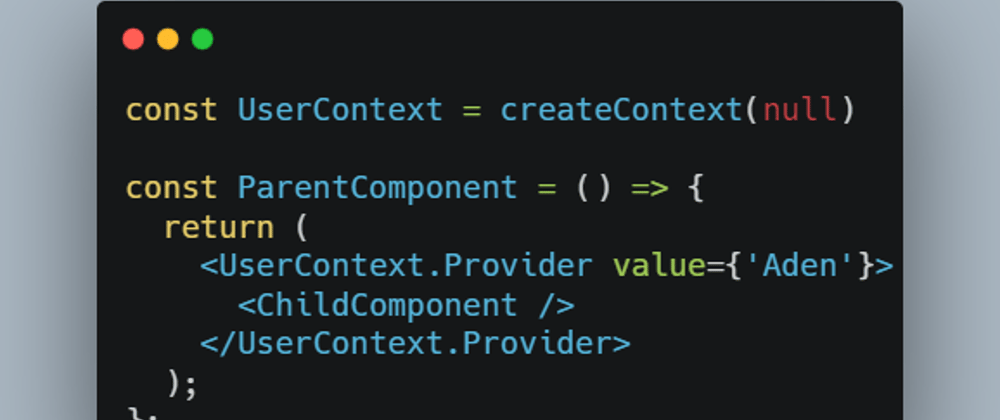What are React hooks?
They are functions in React that allow you to add react functionality to function based components.
What is the useContext hook?
This hook is used to efficiently pass state down the component chain. Prop drilling has historically been used to do this. Prop drilling is the process of passing state values as props deep down a component chain. Often times, this results in passing props to components that do not need them. The useContext hook allows us to pass state values down the component chain without prop drilling.
The best applications for this hook are to pass global values to children components. A few example use cases are application theme switching, and logged in user information (user id, user name...). This hook is not recommended as a replacement for the state management library Redux. Currently it is not robust enough to handle many of Redux's use cases. This hook can work great for small applications that may only have a few globally used pieces of state.
The syntax follows a common pattern:
import { createContext, useContext } from "react";
//Initialize our context.
//null is the default value if none are later provided.
//Often this is done in a different file.
const UserContext = createContext(null)
const ParentComponent = () => {
//We wrap our children component in the Provider
return (
<UserContext.Provider value={'Aden'}>
<ChildComponent />
</UserContext.Provider>
);
};
const ChildComponent = () => {
//Access the context passed down from the ParentComponent
const user = useContext(UserContext)
return (
<>
<h1>Child Component</h1>
<p>{user}</p>
</>
);
};
export default ParentComponent;
Here is an example using the useEffect and useState hooks:
import { useState, useEffect, createContext, useContext } from "react";
const UserContext = createContext(null)
const App = () => {
const [users, setUsers] = useState([]);
useEffect(() => {
const fetchData = async () => {
//Fetches a list of ten users
const response = await fetch(
"https://jsonplaceholder.typicode.com/users"
);
// If the HTTP status code is 200-299
if (response.ok) {
const json = await response.json();
setUsers(json);
}
};
fetchData();
}, []);
return (
<UserContext.Provider value={users}>
<ChildComponent1 />
</UserContext.Provider>
);
};
const ChildComponent1 = () => {
//This component does not need the users data
return (
<>
<h1>ChildComponent1</h1>
<ChildComponent2 />
</>
)
}
const ChildComponent2 = () => {
const users = useContext(UserContext)
return (
<div>
<ul>
{/*If the data exists, display a list of
users names*/}
{users &&
users.map((user) => {
return <li key={user.id}>{user.name}</li>;
})}
</ul>
</div>
)
}
export default App;
More information about useContext can be found in the React docs: https://reactjs.org/docs/context.html
Leave comment if you have any questions or feedback.







Top comments (8)
No, it's not a state manager.
Quote:
At best it's a mechanism used for dependency injection of globally shared values. So it's a good place to keep a reference to a handle that allows you to subscribe to an actual state manager where the state changes do not propagate through context.
The change detection in context allows components to "catch" when their provider becomes available. Values exposed via context are expected to change extremely infrequently if at all.
Why React Context is Not a "State Management" Tool (and Why It Doesn't Replace Redux)
Very good point! I made edits to the post to reflect this. Thank you for the article. I read it and learned a lot.
But what is the alternative? This is a hotly debated issue!
As for me, I use the context as a STORE in many projects.
If I have to optimize a branch of the VIEW I use "useMemo" on the components.
The result is an absolutely acceptable speed and above all a very clean and maintainable code.
From the article already linked to:
So using context in this fashion is outside of it's intended use of sharing data which changes infrequently. People seem to use context for state management because "it seems to work well enough" - lets hope "until it doesn't" never comes.
Kent C. Dodds escalation past using "just context" is to use Jotai.
The creator of Jotai, Daishi Kato, published the blog post When I Use Valtio and When I Use Jotai where he differentiates between
This aligns with Mark Erikson's earlier observation:
Michel Westrate, creator of Mobx advocates for app-centric design in UI as an Afterthought.
Depending on the type of application perhaps an app-centric design could be more appropriate than the apparent default of component-centric design.
Using context for DIY state management may be symptom of needing to switch to an app-centric design style.
there are a lot of quotes of all kinds on the internet.
As far as I'm concerned:
I've seen a lot of "component-centric" applications and it's just a pattern you should never use
Dividing the LOGIC from the VIEW is not "optional" (for medium-large software) especially for SPA applications
@peerreynders after so many days I can tell you. YOU ARE RIGHT!!!
But I give you an alternative! Which is blatant with React18.
reactjs.org/docs/hooks-reference.h...
That is nice.
In some cases I don't want use Redux...
Thanks for the tip.
I use this basic method.
I made a library to make things easier:
JON